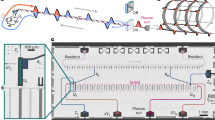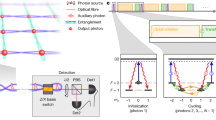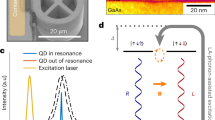Abstract
Quantum computers can revolutionize science and technology, but their realization remains challenging across all platforms. A promising route to scalability is photonic-measurement-based quantum computation, where single-qubit measurements on large cluster states, together with feedforward steps, enable fault-tolerant quantum computation; however, generating large cluster states at high rates is notoriously difficult as detection probabilities drop exponentially with the number of photons comprising the state. We tackle this challenge by encoding multiple qubits on each photon through high-dimensional spatial encoding, generating cluster states with over nine qubits at a rate of 100 Hz. We also demonstrate that high-dimensional encoding substantially reduces the computation duration by enabling instantaneous feedforward between qubits encoded in the same photon. Our findings pave the way for resource-efficient measurement-based quantum computation using high-dimensional entanglement.
This is a preview of subscription content, access via your institution
Access options
Access Nature and 54 other Nature Portfolio journals
Get Nature+, our best-value online-access subscription
$32.99 / 30 days
cancel any time
Subscribe to this journal
Receive 12 print issues and online access
$259.00 per year
only $21.58 per issue
Buy this article
- Purchase on SpringerLink
- Instant access to full article PDF
Prices may be subject to local taxes which are calculated during checkout




Similar content being viewed by others
Data availability
All data are available in the main text and Supplementary Information, or at https://doi.org/10.5281/zenodo.8358012 (ref. 63).
References
Daley, A. J. et al. Practical quantum advantage in quantum simulation. Nature 607, 667–676 (2022).
Shor, P. W. Algorithms for quantum computation: discrete logarithms and factoring. In Proc. 35th Annual Symposium on Foundations of Computer Science 124–134 (ACM, 1994).
Preskill, J. Quantum computing in the NISQ era and beyond. Quantum 2, 79 (2018).
Knill, E., Laflamme, R. & Milburn, G. J. A scheme for efficient quantum computation with linear optics. Nature 409, 46–52 (2001).
Raussendorf, R., Browne, D. E. & Briegel, H. J. Measurement-based quantum computation on cluster states. Phys. Rev. A 68, 022312 (2003).
Browne, D. E. & Rudolph, T. Resource-efficient linear optical quantum computation. Phys. Rev. Lett. 95, 010501 (2005).
Tóth, G. & Gühne, O. Detecting genuine multipartite entanglement with two local measurements. Phys. Rev. Lett. 94, 060501 (2005).
Walther, P. et al. Experimental one-way quantum computing. Nature 434, 169–176 (2005).
Yao, X.-C. et al. Experimental demonstration of topological error correction. Nature 482, 489–494 (2012).
Thomas, P., Ruscio, L., Morin, O. & Rempe, G. Efficient generation of entangled multiphoton graph states from a single atom. Nature 608, 677–681 (2022).
Freedman, S. J. & Clauser, J. F. Experimental test of local hidden-variable theories. Phys. Rev. Lett. 28, 938 (1972).
Cogan, D., Su, Z.-E., Kenneth, O. & Gershoni, D. Deterministic generation of indistinguishable photons in a cluster state. Nat. Photon. 17, 324–329 (2023).
Erhard, M., Krenn, M. & Zeilinger, A. Advances in high-dimensional quantum entanglement. Nat. Rev. Phys. 2, 365–381 (2020).
Vallone, G., Pomarico, E., Mataloni, P., De Martini, F. & Berardi, V. Realization and characterization of a two-photon four-qubit linear cluster state. Phys. Rev. Lett. 98, 180502 (2007).
Chen, K. et al. Experimental realization of one-way quantum computing with two-photon four-qubit cluster states. Phys. Rev. Lett. 99, 120503 (2007).
Ceccarelli, R., Vallone, G., De Martini, F., Mataloni, P. & Cabello, A. Experimental entanglement and nonlocality of a two-photon six-qubit cluster state. Phys. Rev. Lett. 103, 160401 (2009).
Vallone, G., Pomarico, E., De Martini, F. & Mataloni, P. Active one-way quantum computation with two-photon four-qubit cluster states. Phys. Rev. Lett. 100, 160502 (2008).
Reimer, C. et al. High-dimensional one-way quantum processing implemented on d-level cluster states. Nat. Phys. 15, 148–153 (2019).
Vigliar, C. et al. Error-protected qubits in a silicon photonic chip. Nat. Phys. 17, 1137–1143 (2021).
Zhang, H. et al. Encoding error correction in an integrated photonic chip. PRX Quantum 4, 030340 (2023).
Mirhosseini, M. et al. High-dimensional quantum cryptography with twisted light. New J. Phys. 17, 033033 (2015).
Leedumrongwatthanakun, S. et al. Programmable linear quantum networks with a multimode fibre. Nat. Photon. 14, 139–142 (2020).
Goel, S. et al. Inverse-design of high-dimensional quantum optical circuits in a complex medium. Nat. Phys. 20, 232–239 (2024).
Zheng, Y. et al. Multichip multidimensional quantum networks with entanglement retrievability. Science 381, 221–226 (2023).
Ecker, S. et al. Overcoming noise in entanglement distribution. Phys. Rev. X 9, 041042 (2019).
Istrati, D. et al. Sequential generation of linear cluster states from a single photon emitter. Nat. Commun. 11, 5501 (2020).
Walborn, S. P., Monken, C., Pádua, S. & Ribeiro, P. S. Spatial correlations in parametric down-conversion. Phys. Rep. 495, 87–139 (2010).
Calsamiglia, J. Generalized measurements by linear elements. Phys. Rev. A 65, 030301 (2002).
Paesani, S., Bulmer, J. F., Jones, A. E., Santagati, R. & Laing, A. Scheme for universal high-dimensional quantum computation with linear optics. Phys. Rev. Lett. 126, 230504 (2021).
Wang, J. et al. Multidimensional quantum entanglement with large-scale integrated optics. Science 360, 285–291 (2018).
Morizur, J.-F. et al. Programmable unitary spatial mode manipulation. J. Opt. Soc. Am. A 27, 2524–2531 (2010).
Labroille, G. et al. Efficient and mode selective spatial mode multiplexer based on multi-plane light conversion. Optics Exp. 22, 15599–15607 (2014).
Lin, X. et al. All-optical machine learning using diffractive deep neural networks. Science 361, 1004–1008 (2018).
Fontaine, N. K. et al. Laguerre–Gaussian mode sorter. Nat. Commun. 10, 1865 (2019).
Kupianskyi, H., Horsley, S. A. R. & Phillips, D. B. All-optically untangling light propagation through multimode fibres. Optica 11, 101–112 (2023).
Brandt, F., Hiekkamäki, M., Bouchard, F., Huber, M. & Fickler, R. High-dimensional quantum gates using full-field spatial modes of photons. Optica 7, 98–107 (2020).
Hiekkamäki, M. & Fickler, R. High-dimensional two-photon interference effects in spatial modes. Phys. Rev. Lett. 126, 123601 (2021).
Lib, O., Sulimany, K. & Bromberg, Y. Processing entangled photons in high dimensions with a programmable light converter. Phys. Rev. Appl. 18, 014063 (2022).
Gühne, O. & Tóth, G. Entanglement detection. Phys. Rep. 474, 1–75 (2009).
Prevedel, R. et al. High-speed linear optics quantum computing using active feed-forward. Nature 445, 65–69 (2007).
Danos, V. & Kashefi, E. Determinism in the one-way model. Phys. Rev. A 74, 052310 (2006).
Zhou, D., Zeng, B., Xu, Z. & Sun, C. Quantum computation based on d-level cluster state. Phys. Rev. A 68, 062303 (2003).
Gokhale, P. et al. Asymptotic improvements to quantum circuits via qutrits. Proc. 46th International Symposium on Computer Architecture 554–566 (ACM, 2019).
Wang, Y., Hu, Z., Sanders, B. C. & Kais, S. Qudits and high-dimensional quantum computing. Front. Phys. 8, 589504 (2020).
Karácsony, M., Oroszlány, L. & Zimborás, Z. Efficient qudit-based scheme for photonic quantum computing. SciPost Phys. Core 7, 032 (2024).
Campbell, E. T., Anwar, H. & Browne, D. E. Magic-state distillation in all prime dimensions using quantum reed-muller codes. Phys. Rev. X 2, 041021 (2012).
Booth, R. I., Kissinger, A., Markham, D., Meignant, C. & Perdrix, S. Outcome determinism in measurement-based quantum computation with qudits. J. Phys. A 56, 115303 (2023).
Sciara, S. et al. Universal N-partite d-level pure-state entanglement witness based on realistic measurement settings. Phys. Rev. Lett. 122, 120501 (2019).
Raussendorf, R., Harrington, J. & Goyal, K. Topological fault-tolerance in cluster state quantum computation. New J. Phys. 9, 199 (2007).
Chen, S. et al. Heralded three-photon entanglement from a single-photon source on a photonic chip. Phys. Rev. Lett. 132, 130603 (2024).
Cao, H. et al. Photonic source of heralded Greenberger–Horne–Zeilinger states. Phys. Rev. Lett. 132, 130604 (2023).
Joo, J., Knight, P. L., O’Brien, J. L. & Rudolph, T. One-way quantum computation with four-dimensional photonic qudits. Phys. Rev. A 76, 052326 (2007).
Luo, Y.-H. et al. Quantum teleportation in high dimensions. Phys. Rev. Lett. 123, 070505 (2019).
Hu, X.-M. et al. Experimental high-dimensional quantum teleportation. Phys. Rev. Let. 125, 230501 (2020).
Okoth, C., Cavanna, A., Santiago-Cruz, T. & Chekhova, M. Microscale generation of entangled photons without momentum conservation. Phys. Rev. Lett. 123, 263602 (2019).
Santiago-Cruz, T. et al. Resonant metasurfaces for generating complex quantum states. Science 377, 991–995 (2022).
Carolan, J. et al. Universal linear optics. Science 349, 711–716 (2015).
Morimoto, K. et al. Megapixel time-gated SPAD image sensor for 2D and 3D imaging applications. Optica 7, 346–354 (2020).
Cao, H. et al. Photonic source of heralded Greenberger–Horne–Zeilinger states. Phys. Rev. Lett. 132, 130604 (2024).
Azuma, K., Tamaki, K. & Lo, H.-K. All-photonic quantum repeaters. Nat. Commun. 6, 6787 (2015).
Dong, M.-X. et al. Highly efficient storage of 25-dimensional photonic qudit in a cold-atom-based quantum memory. Phys. Rev. Lett. 131, 240801 (2023).
Wehner, S., Elkouss, D. & Hanson, R. Quantum internet: a vision for the road ahead. Science 362, eaam9288 (2018).
Lib, O. & Bromberg, Y. Supplementary data for "Resource-efficient photonic quantum computation with high-dimensional cluster states". Zenodo https://doi.org/10.5281/zenodo.8358012 (2023).
Acknowledgements
We thank O. Katz, B. Dayan and Z. Aqua for helpful discussions. This project was supported by the Zuckerman STEM Leadership Program and the Israel Science Foundation (grant no. 2497/21). O.L. acknowledges the support of the Clore Scholars Programme of the Clore Israel Foundation. This research project was financially supported by the State of Lower Saxony, Hannover, Germany.
Author information
Authors and Affiliations
Contributions
O.L. and Y.B. conceived and conceptualized the project. O.L. designed and built the experimental set-up, performed the experiment, and performed the data analysis under the supervision of Y.B. All authors contributed to the writing of the manuscript.
Corresponding author
Ethics declarations
Competing interests
The authors declare no competing interests.
Peer review
Peer review information
Nature Photonics thanks Che-Ming Li, Peter van Loock and the other, anonymous, reviewer(s) for their contribution to the peer review of this work.
Additional information
Publisher’s note Springer Nature remains neutral with regard to jurisdictional claims in published maps and institutional affiliations.
Supplementary information
Supplementary Information
Supplementary Figs. 1–9 and Supplementary Text.
Rights and permissions
Springer Nature or its licensor (e.g. a society or other partner) holds exclusive rights to this article under a publishing agreement with the author(s) or other rightsholder(s); author self-archiving of the accepted manuscript version of this article is solely governed by the terms of such publishing agreement and applicable law.
About this article
Cite this article
Lib, O., Bromberg, Y. Resource-efficient photonic quantum computation with high-dimensional cluster states. Nat. Photon. 18, 1218–1224 (2024). https://doi.org/10.1038/s41566-024-01524-w
Received:
Accepted:
Published:
Issue date:
DOI: https://doi.org/10.1038/s41566-024-01524-w
This article is cited by
-
Structured light meets machine intelligence
eLight (2025)
-
Twisting entangled photons on a chip
Nature Photonics (2025)



